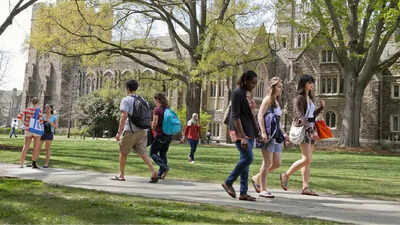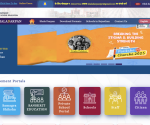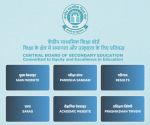Red flags for US higher education: SEVIS data shows decline in international student enrolments – Times of India

Recent analysis of data from the Student and Exchange Visitor Information System (SEVIS) has raised alarm bells regarding international student enrolments in the US for the 2024/25 academic year. According to the data, enrolments have dropped by 11% from March 2024 to March 2025, resulting in a loss of approximately $4 billion in economic impact. This decline comes despite earlier reports from the Institute of International Education (IIE), which indicated a 3% increase in enrolments for Fall 2024.Experts suggest that the decline can be attributed to a combination of rising visa refusal rates, changing international student preferences, and evolving political conditions under the US administration. As reported by ICEF, Chris Glass, a higher education expert at Boston College, highlights that the situation is exacerbated by tightening US immigration policies, including anticipated travel restrictions under President Trump’s administration.Trump’s Policies Stir UncertaintyThe Trump administration’s aggressive stance on higher education, often dubbed a “war on universities,” has heightened fears among international students. Policies such as visa revocations—hundreds of student visas were canceled in early 2025—and threats to cut federal funding for non-compliant institutions have created a chilling effect. For instance, Harvard University faced a temporary halt in its ability to enroll international students, impacting roughly 25% of its student body, before a federal judge intervened. The administration’s actions, including freezing $2.2 billion in Harvard’s federal grants, have raised concerns about financial stability for tuition-dependent colleges.Major declines from key marketsThe SEVIS data reveals significant drops in international student numbers from several key countries, most notably India. Between March 2024 and March 2025, enrolments from India fell by 28%, a sharp reversal of previous growth trends. Mr. Glass, as quoted by ICEF, explained that Indian students are particularly drawn to US graduate STEM programs, and the declining enrolments are linked to visa refusals, affordability issues, and negative perceptions of US policies.Another worrying trend is the 20.5% drop in foreign enrolments in master’s programs, especially within the STEM fields. “International graduate students aren’t supplemental income — they’re critical scientific infrastructure,” said Mr. Glass. “They don’t merely augment American scientific leadership — in many critical domains, they constitute it,” he added. The decrease in master’s-level enrolments could have long-term consequences for the US’s standing in global research and technological development.
Source: Chris GlassDecline in doctoral programsThe downturn is also felt in doctoral programs. As reported by ICEF, the number of international doctoral students has fallen slightly from 175,657 in March 2024 to 167,689 in March 2025. This marks a shift from steady growth in previous years. The following table illustrates the number of international students in doctoral programs over the last decade:
Source: SEVIS Data Mapping ToolVisa refusals and policy changesAs quoted by ICEF, Mr. Glass emphasizes that the rising visa refusal rates and delays in visa processing are major contributors to the decline. He further adds, “These factors, coupled with the uncertainty surrounding US immigration policies, are pushing international students towards other destinations like Canada and the UK.” The situation is exacerbated by stories of mistreatment of international students, including reports of ICE detaining students involved in protests, which has heightened fears among prospective students.The impact of US policies is clear, with Mr. Glass warning, “We don’t need to wait for November to see the warning signs. The data on the dashboard are flashing red before our eyes,” as quoted by ICEF.Financial Fallout for US CollegesInternational students, who often pay full tuition, contributed $43.8 billion to the US economy in 2023-24, supporting over 378,000 jobs. However, with 42% of prospective international students reconsidering US study due to visa restrictions and safety concerns, colleges face significant revenue losses. A survey by IDP Education noted that only 48% of Indian students and 27% of Chinese students view studying in the US positively, reflecting a sharp decline in confidence from key markets. Public research universities, which rely on international tuition to offset declining state funding, are particularly vulnerable.Global Competition IntensifiesAs the US grapples with these challenges, competitors like Canada, Australia, and the UK are capitalizing on the shift. Sweden saw a 37% surge in student interest, while Finland and Singapore reported increases of 36% and 30%, respectively. These countries offer more welcoming visa policies and stable political environments, drawing students away from the US. The IIE warns that continued policy hostility could jeopardize America’s academic and economic strength, as international students like Ma Tianyu, a computer science student from China, weigh safer alternatives abroad despite the allure of US programs.Long-term implications for US higher educationThe decline in international student enrolments could lead to far-reaching consequences for US higher education. As reported by ICEF, government funding for research in scientific fields has already been significantly reduced, including a 78% budget cut for the US National Institutes of Health (NIH). This, Mr. Glass notes, could severely impact the ability of US universities to sustain their leadership in global scientific research.“International students are the backbone of many research labs,” Mr. Glass warned. “Without them, the US risks falling behind in fields like artificial intelligence and renewable energy.” The future of US higher education, as it struggles with these enrolment declines, remains uncertain.
















